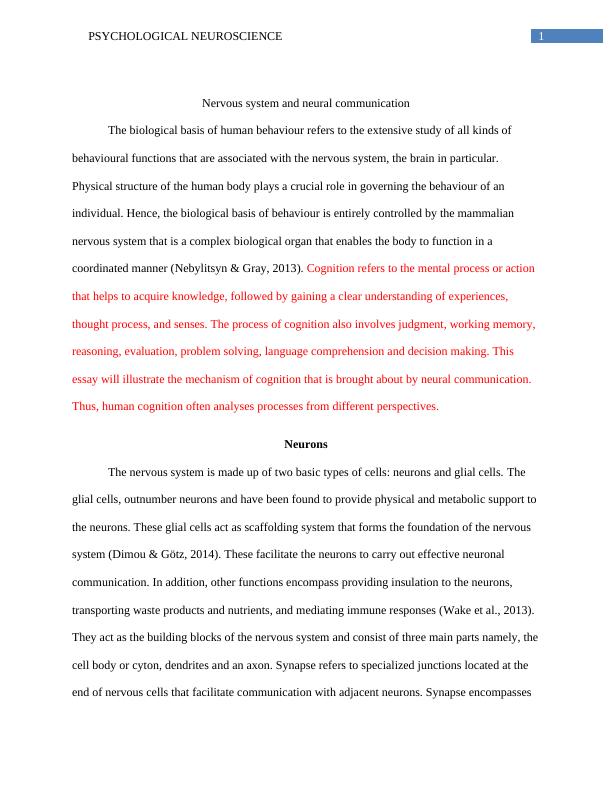Biological Basis of Behaviour: Nervous System and Neural Communication
Added on 2023-06-13
10 Pages2622 Words104 Views
Running head: PSYCHOLOGICAL NEUROSCIENCE
Biological basis of behaviour
Name of the Student
Name of the University
Author Note
Biological basis of behaviour
Name of the Student
Name of the University
Author Note

1PSYCHOLOGICAL NEUROSCIENCE
Nervous system and neural communication
The biological basis of human behaviour refers to the extensive study of all kinds of
behavioural functions that are associated with the nervous system, the brain in particular.
Physical structure of the human body plays a crucial role in governing the behaviour of an
individual. Hence, the biological basis of behaviour is entirely controlled by the mammalian
nervous system that is a complex biological organ that enables the body to function in a
coordinated manner (Nebylitsyn & Gray, 2013). Cognition refers to the mental process or action
that helps to acquire knowledge, followed by gaining a clear understanding of experiences,
thought process, and senses. The process of cognition also involves judgment, working memory,
reasoning, evaluation, problem solving, language comprehension and decision making. This
essay will illustrate the mechanism of cognition that is brought about by neural communication.
Thus, human cognition often analyses processes from different perspectives.
Neurons
The nervous system is made up of two basic types of cells: neurons and glial cells. The
glial cells, outnumber neurons and have been found to provide physical and metabolic support to
the neurons. These glial cells act as scaffolding system that forms the foundation of the nervous
system (Dimou & Götz, 2014). These facilitate the neurons to carry out effective neuronal
communication. In addition, other functions encompass providing insulation to the neurons,
transporting waste products and nutrients, and mediating immune responses (Wake et al., 2013).
They act as the building blocks of the nervous system and consist of three main parts namely, the
cell body or cyton, dendrites and an axon. Synapse refers to specialized junctions located at the
end of nervous cells that facilitate communication with adjacent neurons. Synapse encompasses
Nervous system and neural communication
The biological basis of human behaviour refers to the extensive study of all kinds of
behavioural functions that are associated with the nervous system, the brain in particular.
Physical structure of the human body plays a crucial role in governing the behaviour of an
individual. Hence, the biological basis of behaviour is entirely controlled by the mammalian
nervous system that is a complex biological organ that enables the body to function in a
coordinated manner (Nebylitsyn & Gray, 2013). Cognition refers to the mental process or action
that helps to acquire knowledge, followed by gaining a clear understanding of experiences,
thought process, and senses. The process of cognition also involves judgment, working memory,
reasoning, evaluation, problem solving, language comprehension and decision making. This
essay will illustrate the mechanism of cognition that is brought about by neural communication.
Thus, human cognition often analyses processes from different perspectives.
Neurons
The nervous system is made up of two basic types of cells: neurons and glial cells. The
glial cells, outnumber neurons and have been found to provide physical and metabolic support to
the neurons. These glial cells act as scaffolding system that forms the foundation of the nervous
system (Dimou & Götz, 2014). These facilitate the neurons to carry out effective neuronal
communication. In addition, other functions encompass providing insulation to the neurons,
transporting waste products and nutrients, and mediating immune responses (Wake et al., 2013).
They act as the building blocks of the nervous system and consist of three main parts namely, the
cell body or cyton, dendrites and an axon. Synapse refers to specialized junctions located at the
end of nervous cells that facilitate communication with adjacent neurons. Synapse encompasses

2PSYCHOLOGICAL NEUROSCIENCE
the axon terminals of a neuron, which release neurotransmitters in response to specific impulse
(Hruska & Dalva, 2012). Neurotransmitter or endogenous chemicals facilitate neurotransmission.
The neurotransmitters are responsible for transmitting signals across the chemical synapses at the
neuromuscular junction. Most common neurotransmitters are classified into a range of categories
such as, amino acids, monoamines, trace amines, purines and peptides (Deutch, 2014).
Transmission of nerve impulse along one neuron to the adjacent one occurs due to several
electrical changes across the semi permeable membrane. Arrival of a stimulus leads to the
development of an action potential that brings about a response.
Parts of the brain involved in behaviour
The amygdala contains two almond shaped nuclei groups that are located in the temporal
lobes of the brain and control emotions. Sensory stimuli reach the amygdala basolateral complex,
during emotional events, such as, fear and form connects with stimuli memories. These
emotional memories are stored in the neuronal connections (Townsend et al., 2013). The
hippocampus is the principle structure involved in various memory functions. It is located
adjacent to the limbic system and contains cognitive maps that help an individual encode, store
and retrieve memory. Thus, damage to the hippocampus and adjacent regions often lead to
development of anterograde amnesia (Tanaka et al., 2014). The Broca’s area and Wernicke’s
area are regions that are responsible for processing and production of speech. Lesions in these
areas result in disruption to speech production and comprehension. The areas also play an
essential role in grammar, syntax processing and maintaining sentence structure (Tremblay &
Dick, 2016).
the axon terminals of a neuron, which release neurotransmitters in response to specific impulse
(Hruska & Dalva, 2012). Neurotransmitter or endogenous chemicals facilitate neurotransmission.
The neurotransmitters are responsible for transmitting signals across the chemical synapses at the
neuromuscular junction. Most common neurotransmitters are classified into a range of categories
such as, amino acids, monoamines, trace amines, purines and peptides (Deutch, 2014).
Transmission of nerve impulse along one neuron to the adjacent one occurs due to several
electrical changes across the semi permeable membrane. Arrival of a stimulus leads to the
development of an action potential that brings about a response.
Parts of the brain involved in behaviour
The amygdala contains two almond shaped nuclei groups that are located in the temporal
lobes of the brain and control emotions. Sensory stimuli reach the amygdala basolateral complex,
during emotional events, such as, fear and form connects with stimuli memories. These
emotional memories are stored in the neuronal connections (Townsend et al., 2013). The
hippocampus is the principle structure involved in various memory functions. It is located
adjacent to the limbic system and contains cognitive maps that help an individual encode, store
and retrieve memory. Thus, damage to the hippocampus and adjacent regions often lead to
development of anterograde amnesia (Tanaka et al., 2014). The Broca’s area and Wernicke’s
area are regions that are responsible for processing and production of speech. Lesions in these
areas result in disruption to speech production and comprehension. The areas also play an
essential role in grammar, syntax processing and maintaining sentence structure (Tremblay &
Dick, 2016).

End of preview
Want to access all the pages? Upload your documents or become a member.
Related Documents
Biology and Psychology: Understanding the Connectionlg...
|11
|3064
|458
Understanding Alzheimer's Disease: Causes, Symptoms, and Impact on the Human Brainlg...
|11
|790
|161
Biological Communicationlg...
|6
|1311
|129
Psychology Answerslg...
|7
|1383
|443
Difference between positive and negative reinforcementlg...
|8
|1975
|94
Communications Systems Assignmentlg...
|8
|1927
|477
